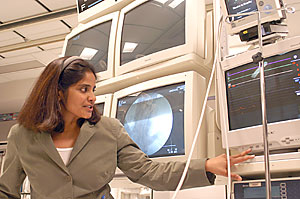 |
|
DJAMILA NOELLE GROSSMAN/Arizona Daily Wildcat
|
University physician Dr. Kalyani Trivedi examines a vital signs monitor in a University Medical Center operating room where a new alternative open-heart surgery procedure took place for the first time last week.
|
|
|
By Djamila Noelle Grossman
Arizona Daily Wildcat
Tuesday, February 22, 2005
Print this
To reduce risks for a 2-year-old girl with heart disease, a University Medical Center physician was the first in Arizona to use a new technique, which allowed closing a hole in the girl's heart and avoiding open-heart surgery.
Alexis Woods, who has had heart problems since she was born, recovered quickly from the procedure, said her mother, Kelly Woods.
"She has been a lot better; she has more strength, more energy and started eating thoroughly," Kelly Woods said. "It's healing faster than I expected."
Traditionally, when a person has a hole between the two heart chambers, called the Ventricular Septal Defect, open-heart surgery has been required. In this procedure, surgeons would also have to use a heart lung-bypass machine and cut into the heart directly in order to reach the hole, said Dr. Kalyani Trivedi, UMC health care physician who performed the procedure.
After the surgery, the patient would have to stay in the intensive care unit for seven to 10 days, said Trivedi, an assistant professor in the department of pediatrics at the UA.
Instead, Trivedi said she used the Amplatzer VSD Muscular Occlude, which consists of a wire body filled with polyester mesh and has the shape of a disk. The disk can be pulled into a small tube, which travels in the body's veins in order to reach the heart.
With the new device, patients can be released as soon as one day after the device was placed, she said.
"You can avoid all those issues and the child goes home with just that little scar that you can't even see after some time," Trivedi said.
Alexis Woods had a special condition, which made the conventional surgery risky, and therefore, Trivedi decided to try the new method, she said.
"We still do that (old method), but this particular child had a defect which was placed in a location where access was hard. It was very hidden and not fully visualized," Trivedi said. "It was prone to a lot of future problems."
Once the disk is released in the heart by pushing it out of the tube, it spreads out and covers the hole. Within a few months, the heart tissue grows along the disk over the hole and closes it, but the disk stays in the heart, Trivedi said.
Kelly Woods said agreeing to the procedure was a hard decision because it is still very new and the doctors are not that experienced with it yet.
"It was really stressful, but the only option because she wasn't doing well," Kelly Woods said. "It was also the best option. Shortly after the procedure, Alexis was talking and drinking apple juice."
Trivedi had to get permission from the Food and Drug Administration to use the device, because it is not yet released for general use in the United States, she said.
However, the device has gone through the first phase of trial and is being used for some patients.
"We had to apply and explain what the situation was and we got approval for use in this single patient," Trivedi said.
Trivedi went to Canada two years ago to undergo a special training on how to use Amplatzer devices, she said.
Very strict rules apply to the use of the device. Only physicians with certain training may use it if the FDA approves it as the best form of treatment for a patient, Trivedi said.
Patients with this type of syndrome could have heart failure, skin discoloration due to a lack of oxygen in the blood, and a very limited ability to exercise, depending on the size and position of the hole, Trivedi said.
"You can't really survive and you definitely need medical help and surgical help, and in the past we used to definitely need surgery," Trivedi said. "Maybe in the future with this type of device, it might get much easier to manage this patient."
